Unlike sugar scrubs made with only oils and sugar, emulsified sugar scrubs become a creamy exfoliating lotion upon contact with water, leaving no oily residue, but only soft, supple skin behind.
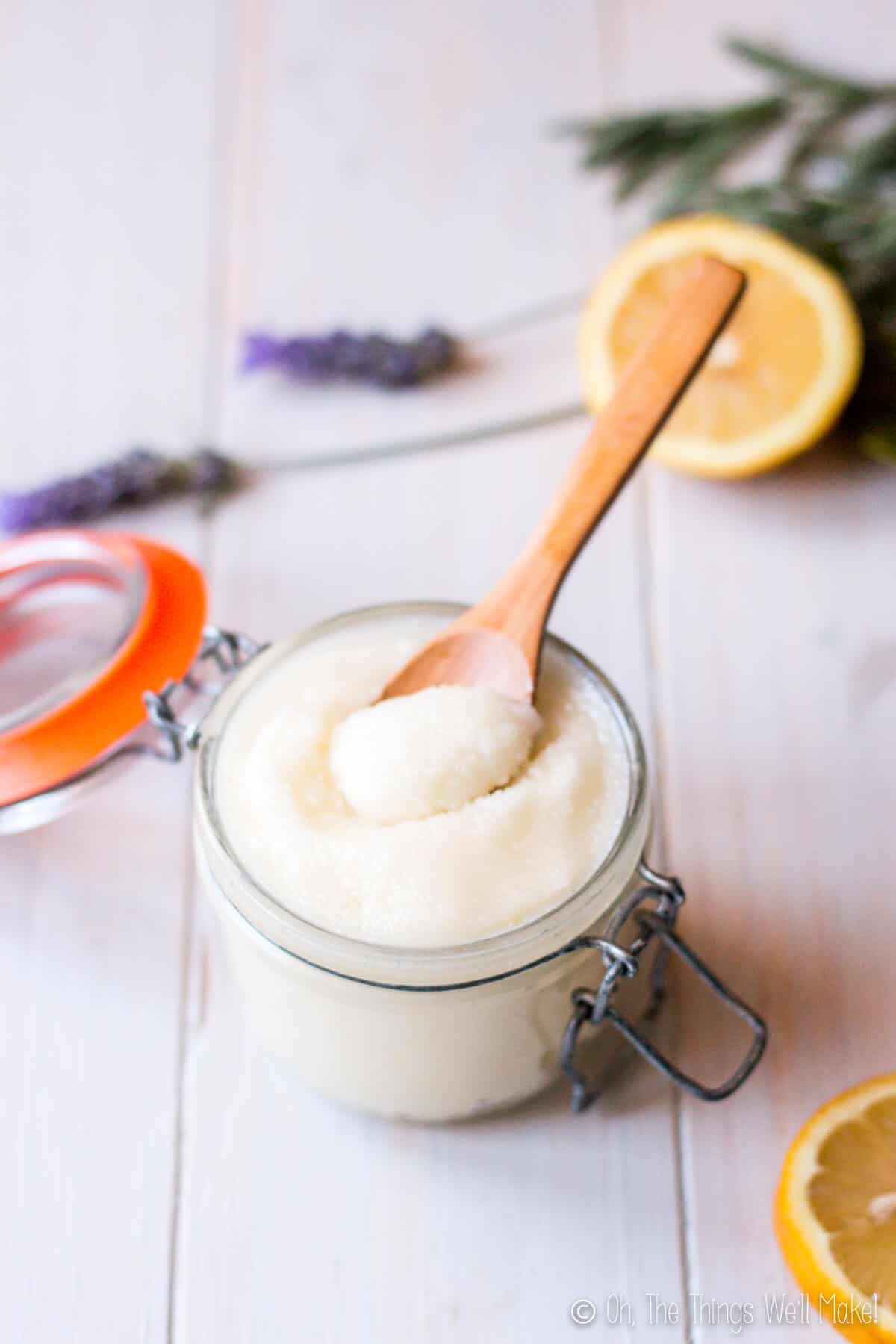
One of the most common DIY beauty products that can be found online is sugar and salt scrubs. Perhaps the main reason that these products are so popular is that they are very easy to make. Basically, you take some oil and mix it together with either sugar and salt, and you’re essentially done. Sure, you can customize your recipe with different oils, sugar types, essential oils, and/or add in other exfoliants or colorants, but most of these recipes are essentially the same.
I’m not going to criticize these recipes. In fact, one of the first DIY recipes on my blog was a brown sugar lip scrub. As you may have guessed, I mostly used it to exfoliate my lips, but also tried using it in the shower to exfoliate my skin.
The benefit of emulsified sugar scrubs
The problem with regular sugar scrubs is that they tend to be messy to use. The oil doesn’t provide a lot of structure for your product, so it’s usually hard to scoop into your hands to use in the shower. Sure, you can use coconut oil to give it more body, but as soon as the weather warms up, you’re back to a more liquid product.
You could, of course, add some butters and/or waxes to the scrub to thicken it, but we’re still left with the main problem with sugar scrubs, the oily residue. Because it’s an oil-based product, you usually end up with oil all over your hands, and body, and shower, as well as the container you’re using for your sugar scrub. I liked the smooth feeling of my legs and arms after exfoliating with my homemade sugar scrub but didn’t like the feel of the oily residue all over my body.
Emulsified sugar scrubs don’t leave that sort of oily residue behind. Because they include an emulsifier as one of their ingredients, when the oils and waxes of the product come in contact with water, they basically form an emulsion, or a lotion, on your skin while you are exfoliating away. In the end, emulsified sugar scrubs are like exfoliants and lotions in one product. You’re essentially making an exfoliating creamy cleanser right on your skin as you scrub away.
If you’re lazy like I am, and don’t like having to exfoliate, rinse, and then use lotion once out of the shower, this emulsified sugar scrub is the perfect solution. It leaves your skin clean, smooth, and lotioned up. (Is that a word?)
Watch me make this easy, emulsified sugar scrub:
Should you add a preservative to your sugar scrub?
Because this is still an oil-based product, without any water in it, you technically don’t have to add a preservative to it. The problem with not using a preservative, though, is that you use this product in a very wet environment and likely scoop it out of the jar with wet hands. The likelihood of moisture contaminating your product is very, very high.
That’s why preservatives are usually added to these types of products, and why you have to be very, very careful using it if you choose not to add a preservative. You could even consider adding less sugar and less wax to the scrub so that you end up with a thinner product that you could more easily dispense from a silicone travel tube dispenser or another type of flip cap dispenser. That would allow you to dispense the product without touching it and would help keep water from contaminating your product.
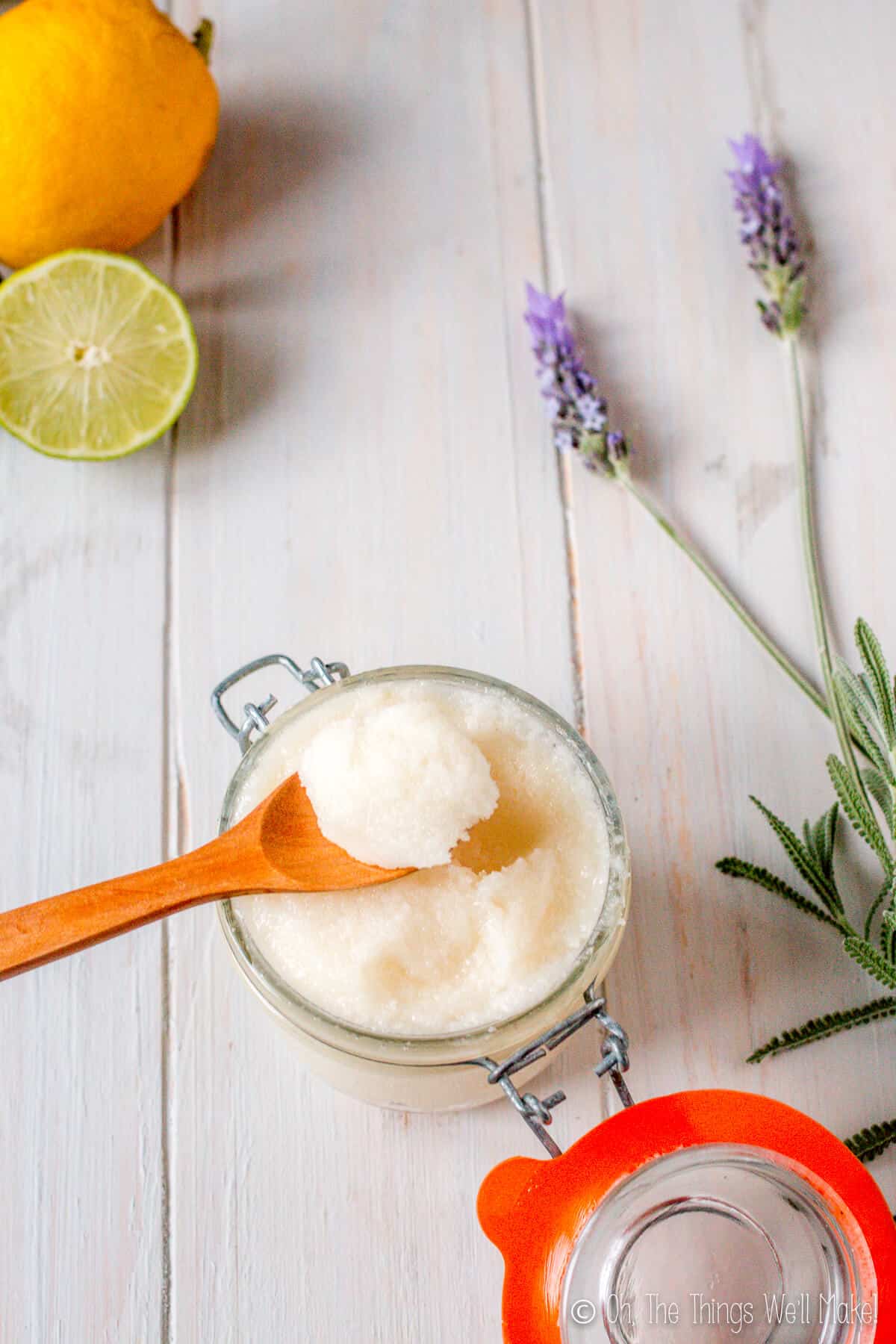
Customizing the emulsified sugar scrub
There are several ways that you can customize this recipe to better suit your taste.
Changing the exfoliant: Salt, sugar, or brown sugar?
While I made this a sugar scrub, you could just as easily add salt to the recipe instead. Salt tends to be a bit more abrasive because the granules aren’t as round and it takes longer for the salt to dissolve, but it really depends on the coarseness of whatever you choose to use. Brown sugar usually has smaller granules and tends to be a lot less abrasive, making it a great option for exfoliating your face.
How much sugar should I use?
When I first made the recipe, I used 120g of sugar and found it to be a nice texture. The next time I made it, I decided I would add more sugar, around 30g more, thinking I’d end up with a thicker scrub (and more of it). In the end, I think it may be a bit on the thick side (as you can see at the end of my video when I’m applying the scrub). It still works well, especially if you are applying it to wet skin, but is a bit harder to apply if it isn’t thinned out with a bit of water. I think somewhere between 120g-150g is a good guideline, and you can adjust the amount to achieve the consistency you prefer.
Customizing the fragrance
I used a combination of lavender, rosemary, and lemon essential oils because I tend to favor citrus herbal scents. You can change the essential oils, though, to suit your tastes. I like lavender because it is calming and soothing for relaxing after a busy day. Lemon can be both soothing or invigorating depending on what you mix it with and when you use it. I don’t normally measure out my essential oils, but use my nose to help decide how much to add.
Which emulsifying wax should you use?
You can use any emulsifying wax that you may happen to have on hand. If you make your own homemade lotions, you should already have one or two of them at home.
If you are very concerned about making a very natural emulsified sugar scrub, consider using an emulsifying wax like olivem. Olivem is a vegetable based emulsifier that is derived from olives. It is allowed in natural, organic products that use the ECO-CERT certification. Olivem is a great option for an emulsifying scrub, too, because some people say that it has a bit of a soap feel to it. In the case of a cleanser, that is more of an advantage than a disadvantage.
Basic, Easy Emulsified Sugar Scrub
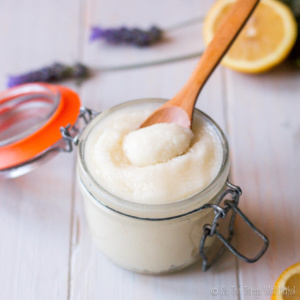
Emulsified Sugar Scrub
Ingredients
- 50 g oil I used sweet almond oil
- 10 g cocoa butter
- 10 g shea butter
- 10 g beeswax or candelilla wax
- 15 g emulsifying wax Olivem is a great choice for this!
- 1 g essential oil (I used lavender, rosemary, and lemon)
- 1 g cosgard or other natural preservative used at the recommended dose
- 150 g sugar (Use less for a slightly thinner product)
Instructions
- Weigh out ad mix together the first 5 ingredients: the oil (but not essential oils), butters, and waxes.
- Melt the oils, butters, and waxes over a double boiler (or in the microwave, if you prefer).
- Once melted, remove from the heat, and stir occasionally as the mixture cools. You can use a mixer to help blend everything together and make a creamy mixture, but it’s not essential.
- Once your mixture has cooled down quite a bit (ideally below 45ºC/115ºF), you can begin to add the essential oils and preservative.
- Make sure the essential oils and preservative are well incorporated into your oils and then begin to add the sugar. Add slowly, and stir constantly, so you can gauge the consistency of the product. Add as much sugar as you like to achieve the desired consistency. (I like it somewhere between 120-150g.)
- To use your sugar scrub, scoop out a small amount in your hands and begin to rub over your wet arms and legs (or any areas you want to exfoliate and hydrate) in a circular motion. As the mixture comes into contact with the water, a lotion will be formed, and the sugar will begin to dissolve, making the product smoother and less abrasive. Rinse any remaining sugar crystals off, and pat your skin dry. Your skin should now feel smooth and hydrated.
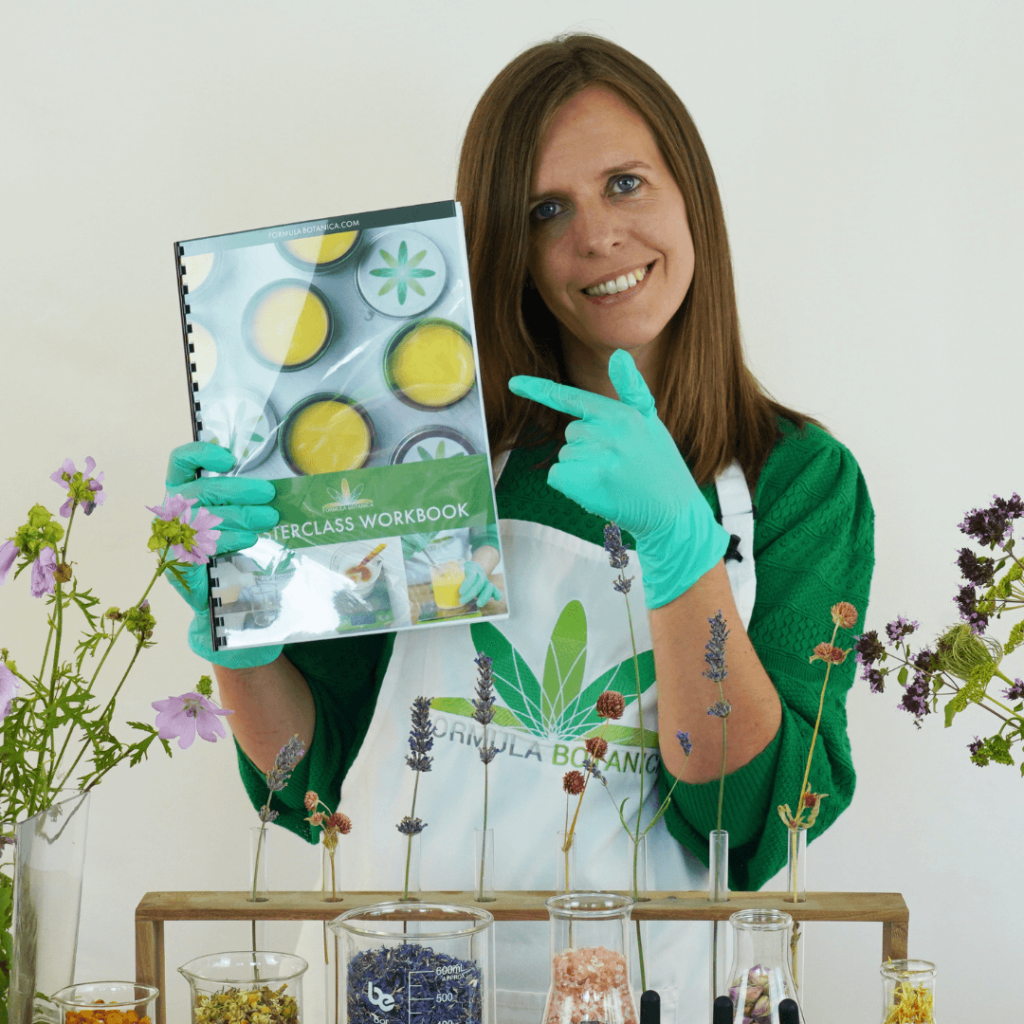
Free Formula Botanic Masterclass!
Running now…
9 free 10-minute classes to help you learn to begin developing professional-grade natural cosmetics in your own home!
 Español
Español
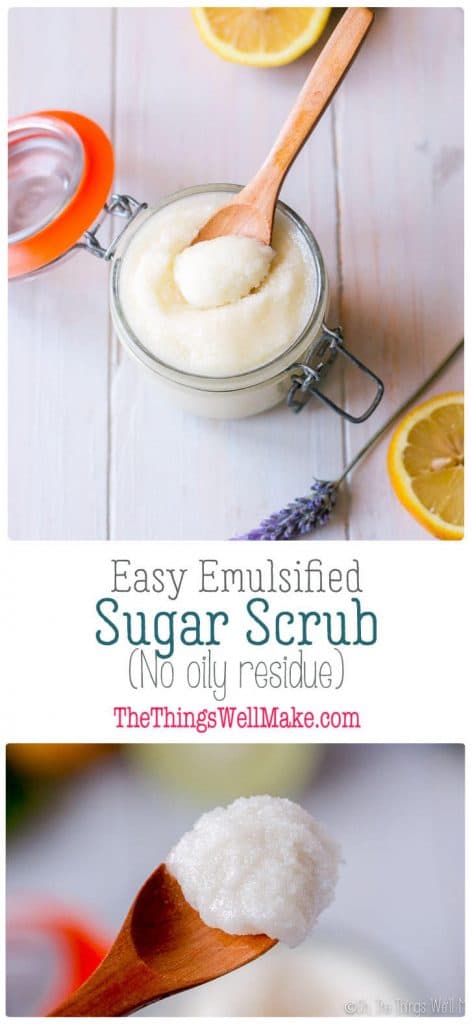
 What are Bitters, and How to Make Them
What are Bitters, and How to Make Them
christine hardman
Hi, I’m going to use Stearite as a preservative, because I’d already ordered it for another recipe, then decided that I liked yours more. Oops!
Tracy Ariza, DDS
Hi Christine,
I’m not sure what type of stearite you are referring to or how it is used as a preservative. I’m not familiar with a stearite that is used as a preservative. So, just make sure to do research on it to make sure it will protect you. (I have a beginner’s guide to natural preservatives that may also help give more information.)
In the end, a preservative isn’t 100% necessary in this recipe as it is oil-based, but you’ll want to make sure not to contaminate it with water if you aren’t using a preservative.
christine hardman
Hi again, the Stearite preservative I have is in wax form, so I’m guessing it will be ok. I can’t use a tub & water is bound to get into the scrub in the shower, so I really want to protect my scrub from going “off.” Thanks for the help, I appreciate it.
Wendy Hawkins
HI, I was wondering what the shelf life of this sugar scrub is?
Tracy Ariza, DDS
Hi Wendy,
Because there are no water-based ingredients, this should theoretically keep for as long as the oils in the recipe. (So, look at the expiration date on the oils you use.)
It’s more about rancidity than other types of preservation.
That said, if it gets contaminated with water, it can go bad more quickly than that, especially if you don’t add a preservative.
NIkki S
I love this recipe! But I find after three days it goes kinda gummy and starts to get hard. Now I used salt instead of sugar. Not sure if that made a diff. How long should it last?
Tracy Ariza, DDS
Hi Nikki,
Because it doesn’t have water-based ingredients, it should keep as long as the ingredients would have otherwise. (Look at the expiration date on your ingredients to have an idea of the shelf life.)
jj
what do i use to color this product
Tracy Ariza, DDS
I’ve never colored it, so I’m not sure if it would stain your bath, etc.
You could try some of the same colorants as are used in soaps. (Maybe even mica powders or something like that?)
Mary
Will a sugar scrub bar go moldy in the shower if it’s bigger, say standard soap bar size? I wanted to make them bigger than just single-use. Thanks!
Mary
Oops, sorry, posted this on the wrong page!
Amanda Rose
Hi! Thank you for sharing and for responding to everyone’s questions so thoughtfully! Do you think I could omit the beeswax and swap out the cocoa butter for more shea? I know that might make the product a little less firm, but would I need to increase or decrease the emulsifying wax or any other ingredients if I made these changes? Also I’m having a card time finding Cosgard but I found Geogard ECT. Is that an equivalent? Its INCI is Benzyl Alcohol & Salicylic Acid & Glycerin & Sorbic Acid. Thank you!
Tracy Ariza, DDS
Hi Amanda,
You’re welcome! I always try to help when I can.
For your first question-yes, definitely. I see no problem in omitting the cocoa butter. This recipe is very forgiving. You could probably even just make a simple emulsion with a liquid oil and add your exfoliators to that. Yes, it would be a bit thinner, but the sugar thickens everything up anyway. I’ll probably end up posting a simpler version someday (soon?) because having a lot of ingredients tends to scare people off. I think I was actually simplifying other recipes out there with this one, but later decided that I could simplify even more! (Consider that some scrubs just use a liquid oil and sugar. The emulsifier already thickens that.)
As for the other…
Geogard is actually another name for Cosgard in some areas (but I had to look up which Geogard as the glycerin didn’t sound familiar to me). Where I live, Geogard 221 is easily found and it is sold with the “Cosgard” name in parentheses after the Geograd 221. Geogard ECT is slightly different and I think the pH range is a bit different, but I imagine it would work here.
Geogard is a water-soluble preservative, and this is an oil-based product, but because of the emulsifiers, I don’t see there being a problem. I can’t find much information about using this particular preservative with oil-based products, so I’m not sure how it would work in a body butter. Some preservatives give a lot of information about that sort of thing.
(I also have a post about natural preservatives that may help, but, yes, it’s a confusing part of formulating sometimes!)
janelle
can you use this as a lip exfoliant. or do you have a recipe for lip scrub with a preservative that will make it last a while?
Tracy Ariza, DDS
Hi Janelle,
It probably would work, but you could just make this simple lip scrub. (If you are careful about not contaminating it with water, you don’t really need a preservative.)
Deborah Simbul
Hi! I was wondering at what stage of the recipe do I add my preservative? Do I add it at the same time that im adding the oils? Thank you!
Tracy Ariza, DDS
Hello Deborah,
Ideally, add it with the essential oils after the mixture has slightly cooled. Many preservatives are quite heat-stable, but some are affected by heat. That’s why it’s best to wait until the end.
susana
Could this formula be made with polysorbate 80? Im just asking because I see it in pretty much all the other recipes out there. I was wondering if it had a great function that we may miss?Thank you!
Tracy Ariza, DDS
Hi Susana,
Yes, I think the polysorbates tend to work well as emulsifiers. I don’t have experience using any of them as I’m a bit more “naturally minded.” The polysorbates are synthetic ingredients. I don’t always avoid all synthetics, and, in fact, sometimes synthetic versions can be safer than natural counterparts (like natural iron oxides that may be contaminated with heavy metals). I mostly avoid these types of ingredients because they are often contaminated with solvents and other ingredients that worry me more.
That doesn’t mean that they are necessarily unsafe nor does it mean that they won’t work. I just prefer to use more natural alternatives when I can find them and they work.
RT
Hello
I intend on making a face scrub with black soap, water,Jojoba seeds and turmeric. Would an emulsifying wax and/or stearic acid be necessary for this product?
Thank you
Tracy Ariza
Hi RT,
If you just want an exfoliating wash, then, no, you don’t need either of those.
The emulsifying wax (and/or stearic acid) are there to emulsify the water and oils. They make more of a thick lotion- so it’s a creamy cleanser vs. a foaming type cleanser like you’d get with soap or other natural surfactants.